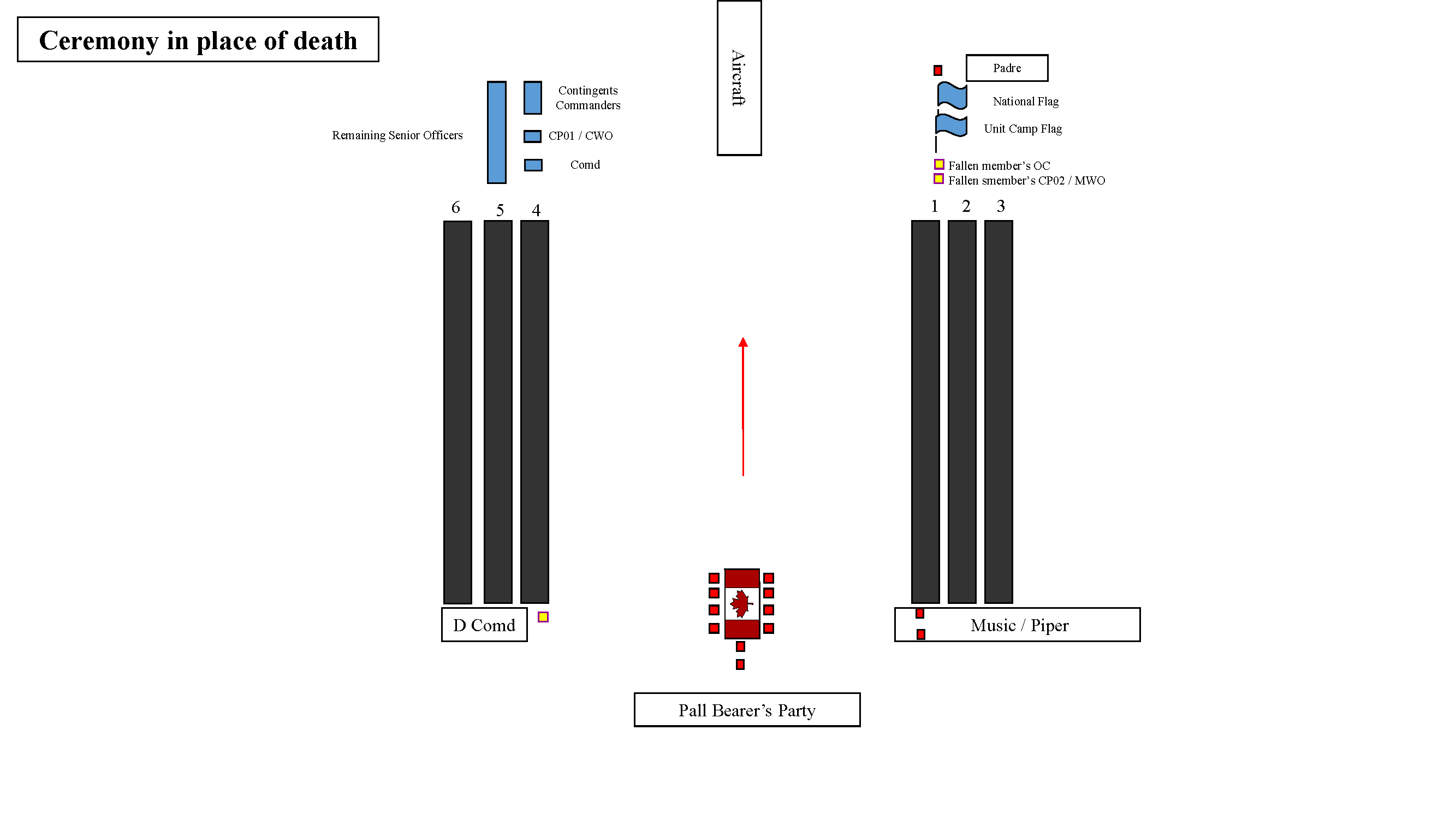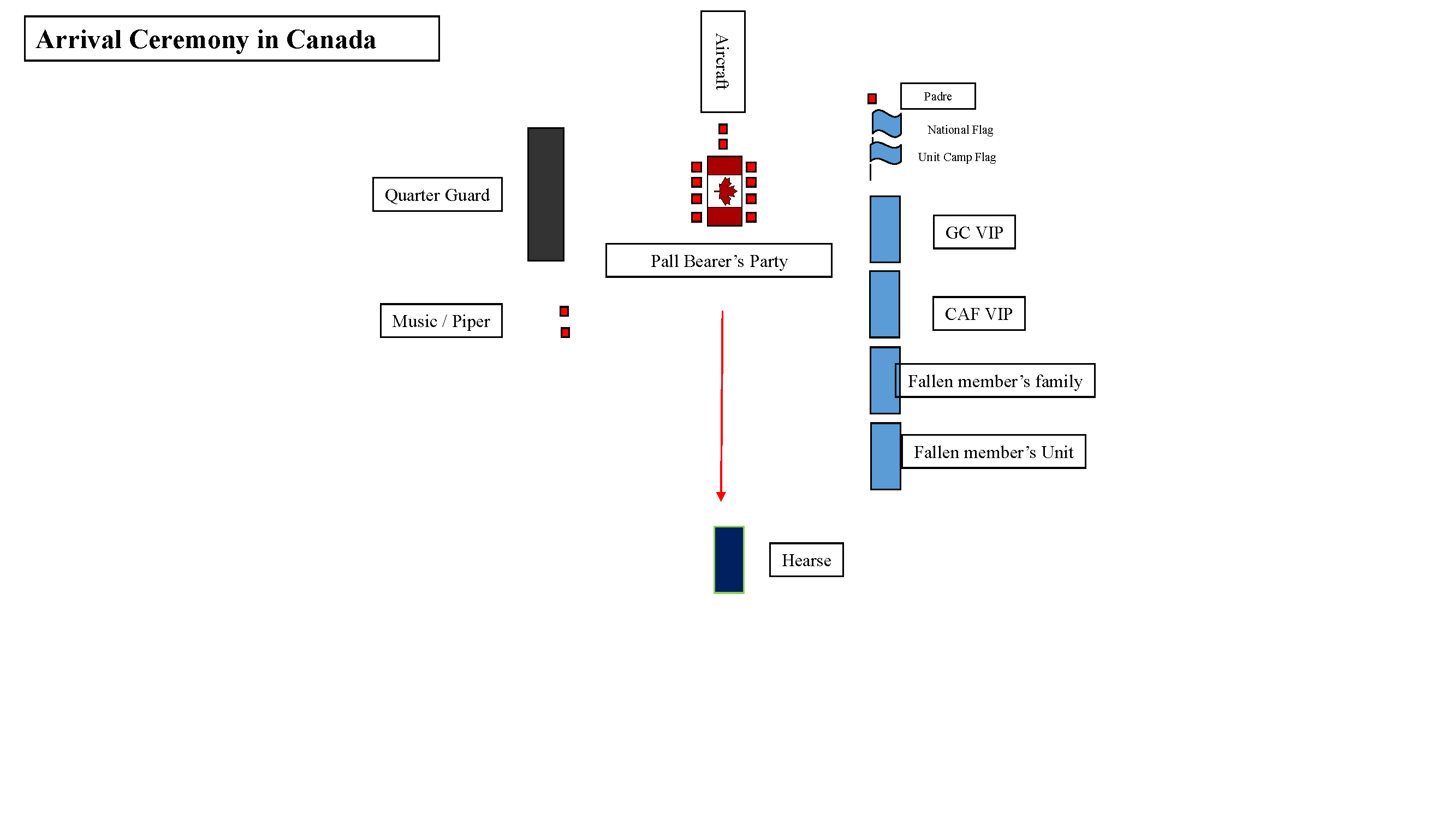Manual of Drill and Ceremonial | Annex A to Chapter 11
- Annex A - Ramp Ceremony 11A-1
- Ceremony in place of death 11A-1
- Members present 11A-1
- Sequence of event 11A-1
- Arrival Ceremony in Canada 11A-1
- Members and guest present 11A-1
- Sequence of event 11A-1
Annex A - Ramp Ceremony
The Ramp Ceremony is complementary to Chapter 11, Section 4 and does not replace existing religious and cemetery ceremonies.
Notes: The accompanying escort must remain near the casket at all times and should be present at all time during the ceremony.
Ceremony in place of death
When the situation permits following the death of one or more members, a ceremony may be held to commemorate and remember. Gathering of the troops of the contingent may be organized under the command of the Deputy Commander of the Contingent. The Contingent Commander, the Sub-Unit Commander and their CPO1/CWO/CPO2/MWO should be present at the assembly. Depending on availability, a military chaplain, bagpiper, trumpeter and a flag party may be present at the ceremony. The ceremony begins when the detachment of pallbearers is in position and begins its movement to the aircraft that will be used to transport the deceased. An address by the military chaplain and the Cmdts may be given. The ceremony ends when the transport is ready to leave the ceremony site. An invitation to foreign contingents must be extended to attend the ceremony.
Members present:
Canadian Contingent Commander and CPO1/CWO,
Fallen Soldier OC and CPO2/MWO,
Padre,
Canadian Flag bearer,
Unit Camp Flag bearer,
Music if available,
Pall bearer party in accordance with chapter 11,
Fallen member's unit,
Canadian contingent,
Contingent from other country.
Sequence of event:
- Arrival of the contingent under control of the DComd
- Bearers party in place
- Arrival of the remains
- Padre allocution
- Transportation of the remains inside the transport, Padre should lead the march, music should play
- Pall bearers march out of the aircraft followed by the padre
- Closing of the Aircraft ramp
- Dismissal of the contingent

Figure 11A-1 - Ceremony in place of death
Arrival Ceremony in Canada
Upon arrival of the deceased on Canadian territory, a ceremony may be held to commemorate and remember. Members of the family(s) of the deceased may be present as well as dignitaries from all levels of government and all military representatives. If available, the unit of the deceased(s) may be represented and should constitute the pallbearers detachment. A quarter guard, bagpiper and trumpeter may be present for the ceremony. The ceremony begins when the preparations for the arrival of the aircraft are completed. The military chaplain leads the way, followed by the detachment of pallbearers as the coffins are moved to the hearses. The family of the deceased may be positioned directly beside the hearse to pay their respects. The ceremony is concluded when the convoy leaves the gathering place.
Members and guest present:
Fallen member's family,
Government of Canada VIP,
CAF VIP
fallen member's Unit
Padre,
Quarter guard,
Music,
Bearer party in accordance with chapter 11,
Sequence of event:
- Transportation arrival, crew preparation
- Quarter guard in place
- Family, VIP GC, CAF VIP, member's Unit in place
- Pall bearers party in place inside the Aircraft
- Quarter guard PRESENT ARMS
- Transportation of the remains to the hearse by the pall bearers party, padre should lead the march, music should play
- Fallen member's family should move to the hearse / if needed family will mount inside VIP transport
- Departure of the hearse, last SALUTE to the fallen member
- Departure of GC VIP, CAF VIP, member's Unit, and family
- Dismiss of the quarter guard and Pallbearers party

Figure 11A-2 - Arrival Ceremony in Canada